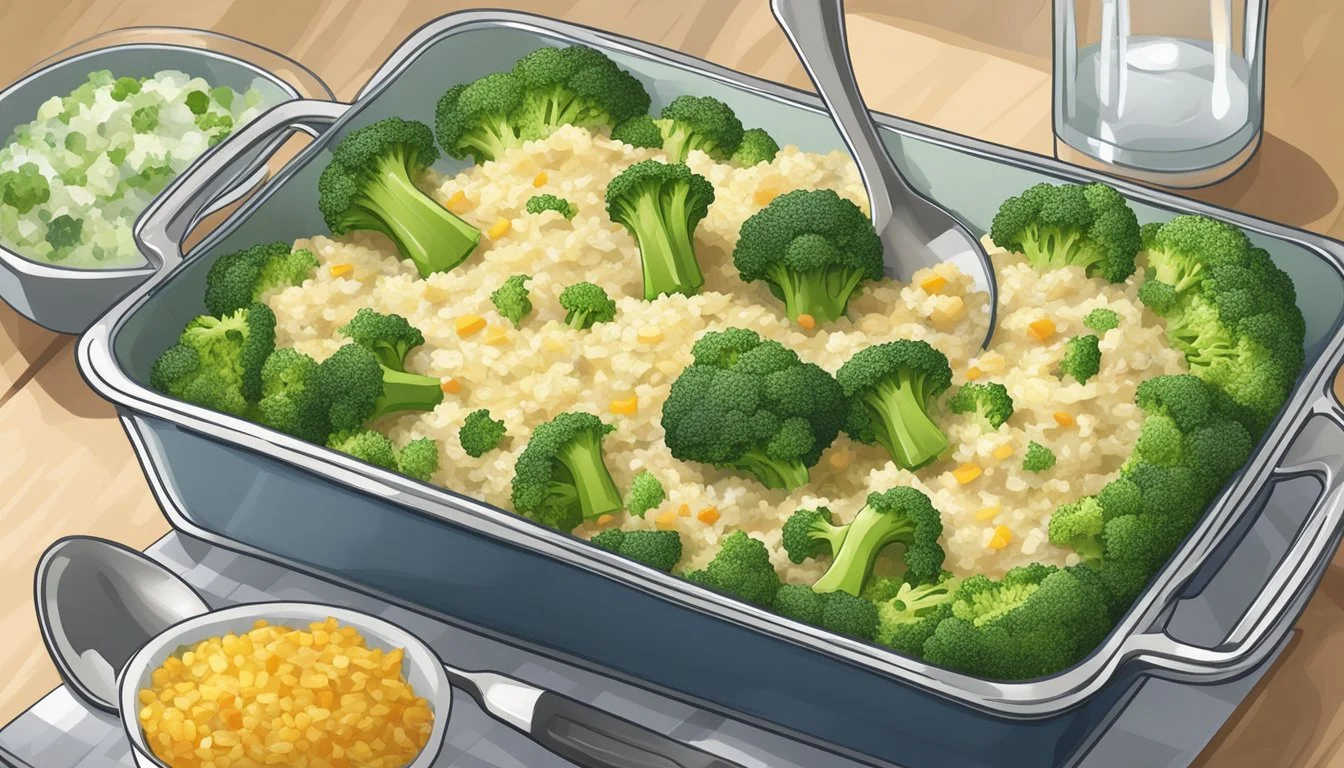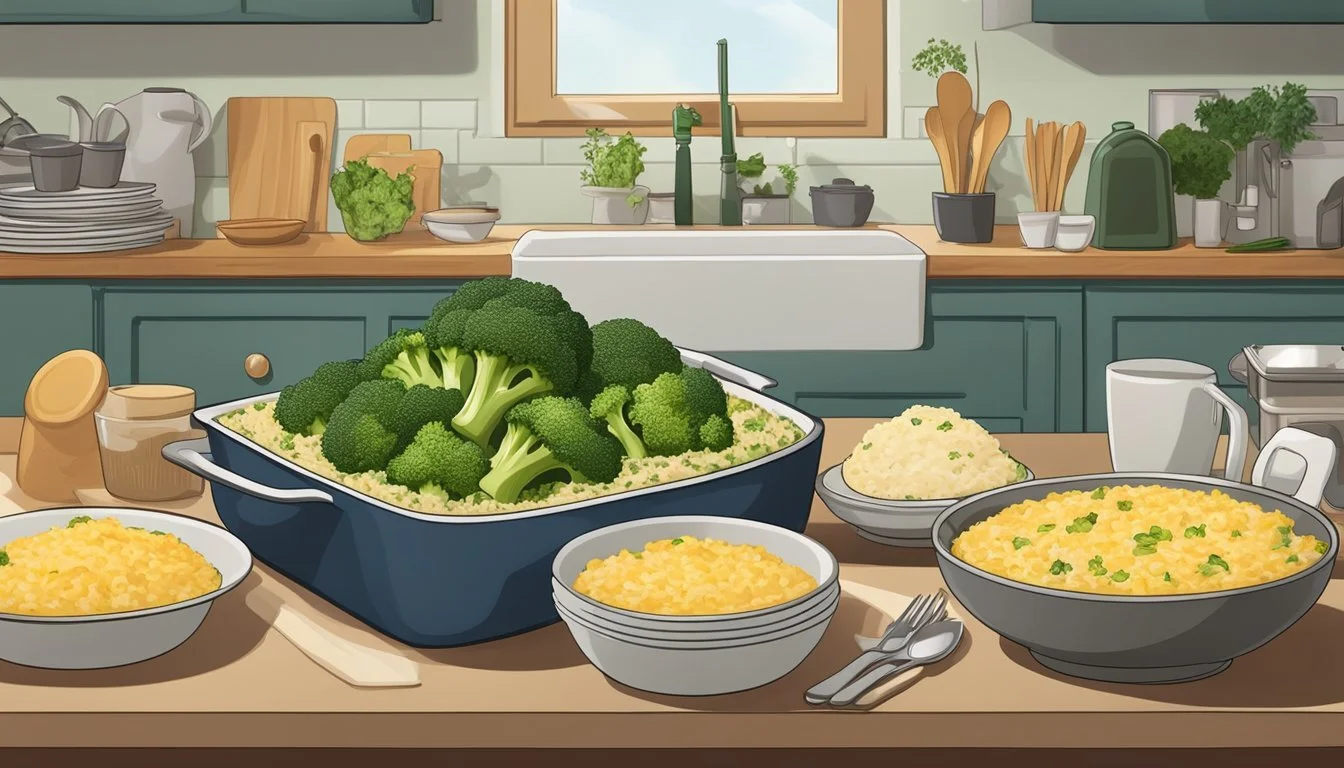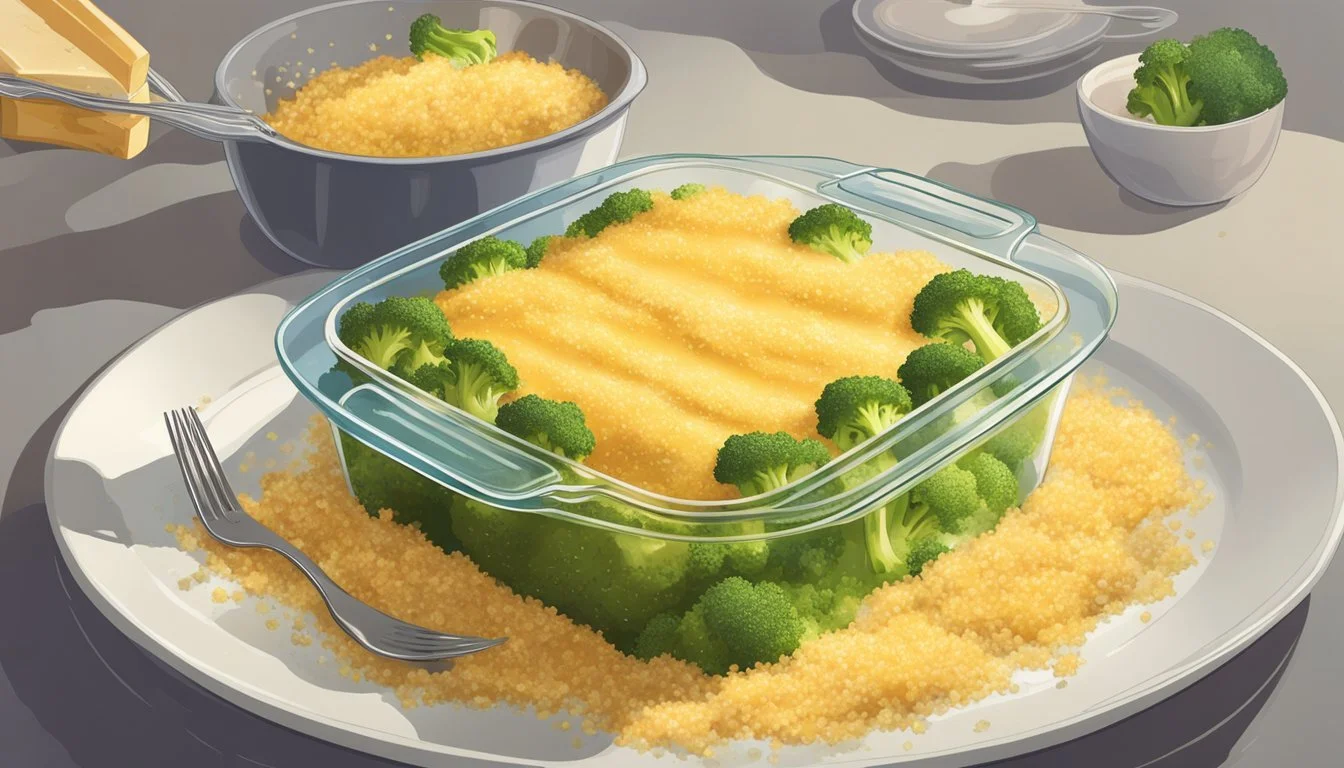How Long Does Broccoli and Rice Casserole Last?
An Expert Guide to Shelf Life and Storage
Broccoli and rice casserole is a staple comfort dish in many households, combining the crunchy freshness of broccoli with the warm, filling texture of rice. It's not only delicious but also convenient for meal preps and leftovers. Typically, broccoli and rice casserole lasts for about 3 to 4 days when stored properly in the refrigerator.
When preparing this dish, it’s important to consider proper storage methods to maintain its freshness. Storing the casserole in an airtight container ensures that it remains safe to eat and retains its flavors. If you prefer to make-ahead and freeze, the casserole can last up to 2 months in the freezer, providing a quick and easy meal option on busier days.
Consuming the casserole within this timeframe is crucial to avoid food spoilage and maintain its quality. Proper reheating techniques should be followed to ensure it’s warmed thoroughly before consumption. This practical information ensures families can enjoy this dish without the worry of it going bad.
Basic Understanding of Broccoli and Rice Casserole
Broccoli and rice casserole is a popular comfort food that combines nutritious ingredients into a single, hearty dish. This dish typically includes broccoli, rice, cheese, and a variety of other ingredients that enhance its flavor and nutritional profile.
Casserole Basics
A broccoli and rice casserole typically starts with cooking the rice according to package directions. Broccoli, which adds a nutritious and vibrant green element, is often blanched or steamed until tender. The cheese sauce is usually made by melting butter or olive oil and sautéing onions and garlic. Flour is then added to make a roux, followed by gradually whisking in milk until the mixture thickens. Cheese like Colby Jack, cream cheese, or a mixture of assorted cheeses is then melted into the sauce. Mixing the rice, broccoli, and cheese sauce together, the casserole is transferred to a baking dish and baked in a preheated oven at around 350°F until the top is golden and bubbly.
Nutritional Information
The nutritional profile of a broccoli rice casserole varies based on the specific ingredients and recipe used. Generally, one serving contains calories, protein, fat, sodium, carbohydrates, saturated fat, cholesterol, potassium, fiber, sugar, vitamin A, vitamin C, calcium, and iron. The precise amounts depend on factors like the type and amount of cheese and milk used, whether additional ingredients like meat or cream are included, and the portion size. For example, the dish is often rich in vitamin C from the broccoli, calcium from the cheese, and carbohydrates from the rice. It is also a good source of protein, especially if combined with chicken or other protein-rich ingredients. However, it's worth noting the potential for high saturated fat and sodium levels, mainly from cheese and butter, so it should be enjoyed in moderation.
Selecting Quality Ingredients
To create a delectable broccoli and rice casserole, selecting high-quality ingredients is paramount. This section will cover the key points for choosing the best broccoli and the right type of rice to ensure a delicious dish.
Choosing Broccoli
Fresh broccoli is the best option for a vibrant and flavorful casserole. Look for heads of broccoli with bright green florets and firm stalks. Avoid any that have yellowing or wilting, as this indicates they are past their prime.
If you prefer frozen broccoli, ensure it's flash-frozen soon after harvesting to retain most of its nutrients. Whether using fresh or frozen, cut the broccoli into bite-sized florets for even cooking.
Quality ingredients like butter for sautéing, garlic for aroma, and cheddar cheese for a rich, creamy sauce enhance the flavor. Adding spices such as paprika and black pepper can offer additional depth.
Opting for the Right Rice
Selecting the right rice is crucial for the texture of your casserole. Long-grain white rice is a common choice due to its fluffy and separate grains when cooked. It readily absorbs flavors from the other ingredients such as chicken stock or cream of mushroom soup.
For a healthier alternative, consider brown rice which offers a nuttier flavor and a chewier texture. Ensure the rice is fully cooked before mixing it with the other ingredients to prevent a gummy consistency.
Integrating elements like sharp cheddar cheese and sautéed onion into the mix will further elevate the taste. Adding Ritz crackers on top before baking can provide a delightful crunch that contrasts with the creaminess of the casserole.
Selecting the right ingredients ensures a cohesive and flavorful broccoli and rice casserole that stands out.
Preparation Techniques
Broccoli and rice casserole is a versatile dish that can be prepared with various methods to suit different tastes. Key techniques involve cooking the casserole and enhancing its flavor and texture.
Cooking the Casserole
For a delicious broccoli and rice casserole, start by preheating the oven to 350°F (175°C). Lightly grease a casserole dish with unsalted butter. Cook the rice according to the package instructions, typically in a microwave or stovetop.
Blanch the broccoli until it is crisp-tender. If using fresh broccoli, boil it for 2-3 minutes, then transfer it to an ice bath. In a skillet, melt unsalted butter and sauté diced onions until translucent. Sprinkle all-purpose flour over the onions and cook for 2 minutes to create a roux. Gradually whisk in milk to form a cheese sauce.
Combine the cooked rice, broccoli, and cheese sauce. Transfer the mixture to the prepared casserole dish. Bake for 35-40 minutes until the top is golden brown and the edges are bubbly.
Enhancing Flavor and Texture
To boost the flavor, add various seasonings such as paprika, mustard powder, or a pinch of nutmeg. For extra richness, incorporate cream cheese into the sauce. Mixing in ingredients like smoked sausage or ham can add a savory depth.
For a crunchy topping, sprinkle breadcrumbs or crushed crackers over the casserole before baking. Mixing the topping with a bit of melted butter enhances the crunchiness. Using a blend of cheeses, such as cheddar and mozzarella, ensures a cheesy, gooey texture that contrasts with the crisp topping.
Storing leftovers in an airtight container can help maintain the casserole’s flavor and texture for longer periods.
Storing Broccoli and Rice Casserole
Proper storage techniques are essential to maintain the freshness and taste of broccoli and rice casserole. Refrigeration and using airtight containers play crucial roles in preserving this dish.
Refrigeration Best Practices
To keep broccoli and rice casserole fresh, place leftovers in an airtight container. This prevents moisture loss and protects it from absorbing odors from other foods in the refrigerator.
Ensure the casserole is cooled to room temperature before refrigerating. Rapid cooling can be achieved by spreading it out in a thin layer.
Store the container at a consistent temperature of 40°F (4°C) or below.
The dish can last up to 3-4 days in the refrigerator. When reheating, make sure the internal temperature reaches at least 165°F (74°C) to ensure it is safe to eat, especially if it contains dairy.
Freezing and Reheating Methods
Properly freezing and reheating broccoli and rice casserole is essential for maintaining its taste and texture. Here are the best practices for freezing and reheating to ensure the dish remains delicious.
Freezing Advice
Using Fresh Ingredients: Ensure the casserole is prepared with fresh ingredients. This maintains maximum flavor and texture after freezing.
Preparation: Allow the casserole to cool completely before freezing. This prevents ice crystals from forming and altering the texture.
Storage: Transfer the cooled casserole into an airtight container or freezer-safe plastic bag. Label with the date to keep track of its storage duration. For optimal quality, consume within 2 months.
Cheese Caution: Cheese in the casserole can change texture when frozen. To address this, consider using a high-quality melting cheese and be prepared to add extra cheese when reheating.
Reheating for Best Quality
Preheat the oven to 350°F (175°C).
Transfer the frozen casserole to an oven-safe dish if needed.
Cover loosely with aluminum foil to retain moisture.
Heat for 30-40 minutes until thoroughly warmed.
Microwave Method:
Place portion in a microwave-safe dish.
Cover loosely with a microwave-safe lid or wax paper.
Heat in 2-4 minute intervals, stirring occasionally, until heated through.
Adding Cheese: To enhance the cheesy goodness, sprinkle additional cheese on top before reheating. This helps restore any lost creaminess.
Frozen Broccoli Consideration: If using frozen broccoli separately, it's best to thaw and drain it before adding to the reheated casserole to maintain texture.
Dinner and Occasion Pairings
Broccoli and rice casserole can be a versatile addition to your meal plans. Whether it's used as a main dish or a side, it pairs well with a variety of meats and vegetarian options for both casual and festive occasions.
Casserole as a Main or Side Dish
For dinner, this casserole can serve as a main dish by itself. Adding cooked chicken, turkey, or ham enhances its protein content, making it a robust entrée. It complements well with a fresh side salad or steamed vegetables for a balanced meal.
For holiday dinners and special gatherings, broccoli and rice casserole works perfectly as a side dish. It pairs remarkably well with roasted meats like turkey or ham, offering a comforting and flavorful companion to the star of your meal. Vegetarians can also enjoy it as it can be adapted to exclude meat.
The comfort food appeal of this casserole makes it ideal for casual family dinners or potlucks. Guests are sure to appreciate its creamy texture and rich flavor profile. It's best served hot but can be made ahead and reheated for convenience, maintaining its appealing taste and texture.
Recipe Variations and Substitutions
Broccoli and rice casserole can be customized to match family preferences or dietary needs through various substitutions in proteins, cheeses, vegetables, and seasonings.
Protein and Cheese Varieties
This casserole can be enriched with proteins such as chicken, ham, or even bacon. Leftover cooked chicken or diced ham are great options that add a savory dimension to the dish. For vegetarian versions, omit the meat entirely and consider doubling the amount of broccoli or adding chickpeas for protein.
Different cheeses impart unique flavors. While cheddar and sharp cheddar cheese are popular, options like cream cheese, Swiss, or Velveeta provide varied textures and tastes. Blending cheeses like cheddar with cream of chicken soup creates a rich, creamy sauce. Using pre-shredded cheese ensures quicker preparation, a boon for make-ahead meals.
Vegetable and Seasoning Alternatives
Broccoli is a staple in this casserole, but it can be swapped or complemented with other vegetables. Consider bell peppers, cauliflower, or mushrooms for additional flavors and nutrients. Onions add a foundational taste and can be sautéed with dry mustard for depth.
Seasonings like garlic, paprika, and thyme can elevate the dish. For those who enjoy a bit of heat, a pinch of red pepper flakes works wonders. Using white rice or brown rice depends on personal preference; brown rice offers a nuttier flavor and additional fiber.
In summary, these variations ensure the casserole can cater to different tastes and dietary requirements, making it both versatile and family-friendly.
Tips for Making Broccoli and Rice Casserole Ahead
Preparing a broccoli and rice casserole ahead of time is a smart strategy, especially during busy holidays like Thanksgiving.
Choose Fresh Ingredients: Using fresh broccoli and high-quality cheese enhances flavor and texture. Blanch the broccoli for two minutes to retain its bright green color and crunch.
Assembly: Assemble the casserole by combining cooked rice, blanched broccoli, and a rich cheese sauce. Use different cheeses like Velveeta, Colby Jack, or cheddar for a flavorful blend.
Storing: Store the assembled casserole in an airtight container or baking dish wrapped tightly with aluminum foil. Label it with the date of preparation.
Freezing: The casserole can be frozen for up to three months. Make sure it’s well-sealed to prevent freezer burn. Thaw it in the refrigerator overnight before baking.
Baking: When ready to bake, preheat the oven to 350°F. Bake the thawed casserole for 45-50 minutes or until the edges are bubbling and the center is hot.
Batch Cooking: For large gatherings, prepare multiple casseroles and freeze them. This approach saves time and ensures there’s enough for everyone during holiday meals.
These tips will help streamline the process and make sure the casserole is delicious and well-prepared for special occasions.






